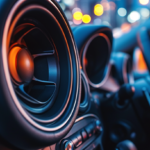Do you want to make your car more efficient and stylish? You can achieve this by improving your car’s aerodynamics. In this article, you will learn simple yet effective techniques to reduce air resistance and optimize your car’s body design. Discover how upgrading and modifying exterior components can enhance your car’s performance. Get ready to explore advanced techniques that will take your car’s aerodynamic performance to the next level.
Understanding the Basics of Aerodynamics
You should understand the basics of aerodynamics to improve your car’s performance. Aerodynamics refers to the study of how air flows around objects, such as cars, and how it affects their movement. By understanding the principles of aerodynamics, you can make changes to your car that will help it move more efficiently through the air, reducing drag and increasing stability. One important concept to grasp is the role of drag in slowing down your car. Drag is the force that opposes the motion of your vehicle and is caused by air resistance. By making changes to your car’s design, such as adding a spoiler or lowering the ride height, you can reduce drag and improve your car’s overall performance.
Analyzing and Reducing Air Resistance
To improve your car’s aerodynamics, start by analyzing and reducing air resistance. Air resistance, also known as drag, is the force that acts against the forward motion of your car. By reducing drag, you can improve your car’s fuel efficiency and performance. One way to analyze air resistance is by examining the shape of your car. A streamlined design, with smooth curves and a low profile, can help reduce drag. Additionally, consider removing any unnecessary accessories or rooftop cargo, as these can increase drag. Another important factor to consider is the condition of your car’s exterior. Keep it clean and free from dirt, as a dirty surface can create turbulence and increase drag. Finally, check for any gaps or openings in your car’s bodywork, as these can also contribute to increased air resistance. By taking these steps, you can effectively reduce air resistance and improve your car’s aerodynamics.
Optimizing the Body Design for Improved Aerodynamics
When optimizing the body design for improved aerodynamics, focus on reducing any unnecessary protrusions or sharp edges. These features create additional drag and hinder the smooth flow of air around your car. Start by evaluating the front end of your vehicle. Consider using a sloping or rounded shape to minimize air resistance. The windshield should be angled back to redirect airflow smoothly over the roof. Avoid adding unnecessary accessories like roof racks or spoilers, as they can disrupt the laminar flow of air. Streamline the side mirrors by opting for smaller, more aerodynamic designs. Additionally, ensure that the underbody of your car is smooth and free from any rough surfaces. By making these simple adjustments, you can greatly improve your car’s aerodynamics and reduce fuel consumption.
Upgrading and Modifying Exterior Components
Consider adding aerodynamic features to your car’s exterior components, such as a front air dam or rear diffuser, to enhance its overall performance. These upgrades can significantly improve your car’s aerodynamics by reducing drag and increasing stability. A front air dam, for example, helps redirect airflow around the car, reducing turbulence and minimizing drag. This can result in improved fuel efficiency and better handling at high speeds. Similarly, a rear diffuser works by creating a low-pressure area under the car, effectively sucking it down onto the road and improving stability. By investing in these modifications, you can enhance your car’s performance, making it more efficient and enjoyable to drive. Additionally, consider installing a spoiler or side skirts for further aerodynamic benefits.
Exploring Advanced Techniques for Maximum Aerodynamic Performance
By experimenting with different aerodynamic modifications, you can maximize your car’s performance and achieve optimal aerodynamic efficiency. While upgrading and modifying exterior components is a good starting point, there are advanced techniques that can take your car’s aerodynamics to the next level. One such technique is the use of a front splitter or air dam. This component, typically mounted under the front bumper, helps to redirect airflow and reduce drag. Another advanced technique is the addition of side skirts or air curtains. These components help to smooth out the airflow along the sides of the car, reducing turbulence and improving aerodynamic efficiency. Additionally, a rear diffuser can be added to the underside of the car to help manage the airflow coming from underneath and reduce rear-end lift. By combining these advanced techniques with other modifications, you can achieve maximum aerodynamic performance and enhance your driving experience.

Lucas is an experienced vehicle technician with hands-on knowledge of almost every car brand available. Throughout his career, Lucas has worked on a wide range of vehicles, including domestic and foreign models, sports cars, trucks, and SUVs.





